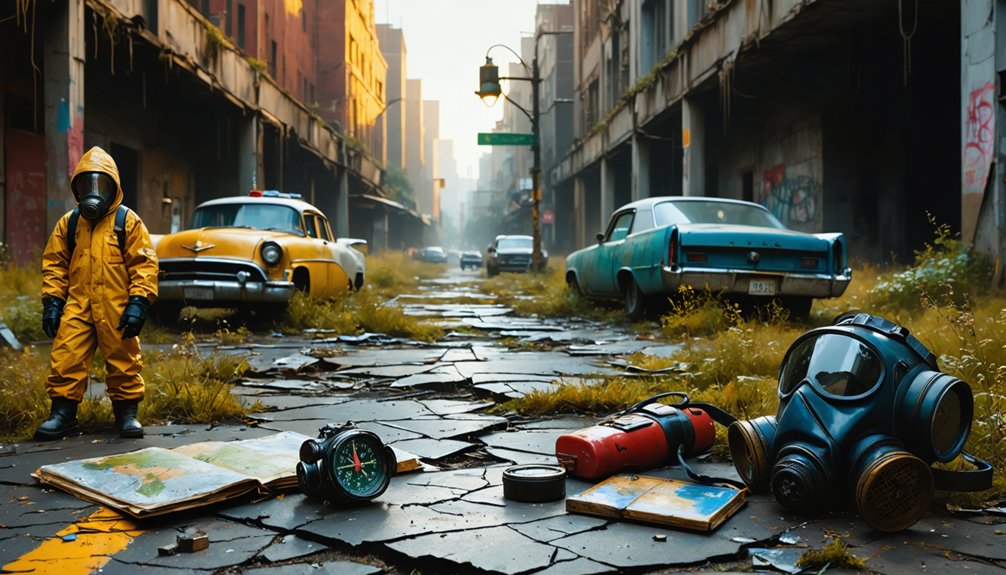You’ll need five essentials for successful ghost town expeditions: proper safety gear (respirator, boots, gloves), navigation skills using landmarks and celestial positioning, a well-prepared vehicle with recovery equipment, documentation tools that respect structural integrity, and an all-encompassing survival kit with first aid supplies. Always assess building stability before entering and maintain communication protocols with your base camp. The difference between adventure and disaster often lies in these fundamental preparations.
Key Takeaways
- Always wear protective gear including respirators, gloves, and sturdy boots to prevent injuries from hazardous materials and unstable terrain.
- Master navigation techniques using landmarks, celestial cues, and triangulation since electronic navigation may be unreliable.
- Thoroughly prepare your vehicle with recovery gear and understand off-road driving techniques before attempting remote locations.
- Assess structural integrity of buildings before entering and use drones to document unstable areas safely.
- Maintain a comprehensive survival kit with first aid supplies, clean water, and communication equipment for emergencies.
Essential Safety Gear for Exploring Abandoned Settlements
When venturing into abandoned settlements, your survival depends on carrying the right protective equipment. Sturdy hiking boots prevent ankle injuries and puncture wounds, while long sleeves and pants shield your skin from hazardous surfaces.
Always wear heavy-duty gloves to handle contaminated objects safely. Your respiratory system needs equal attention—N95 or P100 respirators are non-negotiable when asbestos or mold might be present. Don’t rely on basic medical masks for serious protection. A comprehensive first aid kit should always be accessible for treating minor injuries on site.
Apply mentholated ointment under your nose to combat overwhelming odors. For navigation and safety, carry LED headlamps with backup batteries, offline maps, and doorstops to prevent accidental lockouts.
Maintain communication options and defensive tools like air horns or pepper spray for unexpected encounters. Checking in with someone before exploring and sharing your detailed itinerary adds an essential layer of safety. These health precautions may seem excessive until they save your life.
Charting unmapped territory demands mastery of both ancient wisdom and modern techniques when GPS fails in post-apocalyptic environments.
You’ll need to identify natural landmarks like distinctive mountain ridges and watercourses to maintain orientation while moving through ghost towns and surrounding wilderness.
Develop mental mapping skills by continuously noting spatial relationships between landmarks.
Practice celestial navigation—locate the North Star or Southern Cross at night to establish cardinal directions. During daytime, track the sun’s position and shadow lengths.
When maps exist but are degraded, adapt through triangulation and terrain association.
Match contour lines with real-world elevations to anticipate landscape features. Ridge walking and valley navigation provide efficient travel routes through uncharted areas.
For course correction, use minimal environmental markers like stacked stones while maintaining your ability to backtrack when necessary.
Always keep your situational awareness sharp by constantly reassessing your location and environmental conditions that might alter the terrain around you.
Learning to interpret animal behavior patterns can guide you toward essential resources like water sources when exploring unfamiliar areas.
Vehicle Preparation and Recovery Strategies
Preparing your vehicle for ghost town expeditions requires extensive equipment and strategic planning, especially since mechanical failures in remote post-apocalyptic locations can become life-threatening situations.
Conduct thorough vehicle inspection before departure, understanding your rig’s ground clearance, weight distribution, and approach angles. Pack essential recovery gear: winch, recovery boards, kinetic rope, and rated mount points for extraction from inevitable terrain challenges. Carrying proper recovery gear is crucial for safety and self-reliance in areas where help may never arrive.
- The eerie silence when your engine dies miles from civilization, surrounded by abandoned structures
- The triumphant relief of self-recovering your vehicle from axle-deep mud using proper techniques
- The sinking feeling of watching unprepared explorers become permanently stranded
- The freedom of knowing you can navigate any obstacle with your meticulously prepared rig
Master recovery techniques like winching, board placement, and buddy recovery to maintain your independence in uncharted territories. Remember that in post-apocalyptic settings, your daily activities will revolve around basic survival needs as you navigate through these ghost towns.
Preserving History While Ensuring Your Survival
The delicate balance between historical preservation and personal safety creates unique challenges in post-apocalyptic ghost town exploration.
While documenting architectural remnants, always secure your immediate surroundings first—stabilize entry points and assess structural integrity before conducting detailed historical documentation.
Utilize mapping drones to create digital twins of unstable structures without risking personal exposure to collapse hazards.
When collecting artifacts, photograph items in their original context before removal, maintaining spatial relationships that tell survival stories of previous inhabitants.
The Ghost Town Club has demonstrated how preservation efforts can successfully protect historic sites from further deterioration and vandalism since the 1970s.
Install temporary weather protection like rolled asphalt on compromised roofing to prevent further deterioration while you’re exploring.
Consider creating reference documents that compile important details about the location to ensure consistency in your exploration notes and findings.
Collaborate with other survivor groups to establish standardized artifact preservation protocols that serve both educational purposes and practical survival knowledge transfer—the techniques that sustained previous communities might keep yours alive too.
Building Your Ghost Town Expedition Kit
Successful ghost town exploration in post-apocalyptic environments depends on five critical gear categories that form your expedition foundation.
Prioritize expedition essentials: sturdy boots, protective clothing, first aid supplies, and reliable navigation tools. Your gear organization should focus on accessibility and weight distribution, with essential equipment always within immediate reach.
Organize for survival—keep critical gear accessible and balanced for swift response to unseen dangers.
- Your respirator stands between you and the silent killers—asbestos, lead dust, and toxic mold lurking in crumbling structures.
- Every marked path on your offline map represents a potential escape route when unexpected threats emerge.
- Your communication plan might be the only thread connecting you to rescue if structures collapse.
- That seemingly excessive water supply becomes your lifeline when contaminated sources surround you.
Careful documentation with a journal can help you collect expedition journals that might contain valuable information about previous explorations.
Having healing solutions like antiseptics is crucial for survival, especially when facing the tough areas that define ghost town territories.
Frequently Asked Questions
How Do I Identify Dangerous Radiation Zones in Post-Apocalyptic Settlements?
You’ll find truth in readings, not assumptions. Always carry radiation detection instruments like Geiger counters. Scan systematically for hotspots above 100 CPM. Wear appropriate safety equipment when exploring suspect areas.
What’s the Best Defense Against Hostile Survivor Groups?
Establish early warning systems and maintain surveillance. You’ll need strong group dynamics with clear leadership roles. Deploy trip wires and use guerilla tactics. Form strategic alliances with other survivors. Avoid revealing your position unnecessarily.
Can I Repurpose Abandoned Technology Without Endangering Myself?
You’d think abandoned technology would be your salvation, but it’s often a death trap. Always de-energize systems, check for hazardous materials, and wear protective gear when scavenging. Your freedom depends on smart safety precautions.
How Long Can I Safely Occupy an Abandoned Building?
You shouldn’t occupy abandoned structures longer than 24-48 hours without thorough building safety assessment. For extended stays, conduct urban exploration inspections of structural integrity, water damage, and hazardous material presence every 3-5 days.
What Psychological Effects Should I Prepare for During Extended Expeditions?
Like shadows lengthening at dusk, isolation intensifies during extended expeditions. You’ll need a survival mindset to manage stress, anxiety, and loneliness. Develop emotional resilience through mindfulness techniques while balancing unconscious stress reactions with conscious mental control.
References
- https://www.youtube.com/watch?v=6JywJnUv1Rw
- https://www.cornettfiction.com/describing-a-post-apocalyptic-setting/
- https://nvtami.com/2024/10/06/ghost-towns-are-not-theme-parks-how-to-visit-them-safely/
- https://www.cornettfiction.com/post-apocalyptic-world-building-for-writers/
- https://ouraymountainadventures.com/blog/four-wheeling-routes-in-ouray/
- https://theurbanwriters.com/blogs/publishing/writing-post-apocalyptic-novels
- https://theadventureportal.com/in-search-of-nevada-ghost-town/
- https://give.globaluniversity.edu/42191181/hcampaignso/xadvancesg/uvisitsb/post+apocalyptic+fiction.pdf
- https://kellycodetectors.com/blog/metal-detecting-ghost-towns/
- https://www.goodreads.com/author/show/19208413.Misty_Zaugg/blog/tag/post-apocalyptic-fiction



